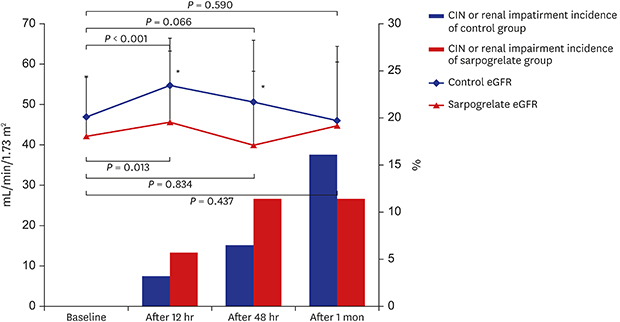1. Weisbord SD, Chen H, Stone RA, Kip KE, Fine MJ, Saul MI, et al. Associations of increases in serum creatinine with mortality and length of hospital stay after coronary angiography. J Am Soc Nephrol. 2006; 17(10):2871–2877.

2. Section 4: contrast-induced AKI. Kidney Int Suppl (2011). 2011; 2(1):69–88.
3. Solomon R. Contrast-medium-induced acute renal failure. Kidney Int. 1998; 53(1):230–242.

4. Mehran R, Nikolsky E. Contrast-induced nephropathy: definition, epidemiology, and patients at risk. Kidney Int Suppl. 2006; 69(100):S11–5.

5. McCullough PA, Adam A, Becker CR, Davidson C, Lameire N, Stacul F, et al. Risk prediction of contrast-induced nephropathy. Am J Cardiol. 2006; 98(6A):27K–36K.

6. Quintavalle C, Fiore D, De Micco F, Visconti G, Focaccio A, Golia B, et al. Impact of a high loading dose of atorvastatin on contrast-induced acute kidney injury. Circulation. 2012; 126(25):3008–3016.

7. Han Y, Zhu G, Han L, Hou F, Huang W, Liu H, et al. Short-term rosuvastatin therapy for prevention of contrast-induced acute kidney injury in patients with diabetes and chronic kidney disease. J Am Coll Cardiol. 2014; 63(1):62–70.
8. Marenzi G, Assanelli E, Campodonico J, Lauri G, Marana I, De Metrio M, et al. Contrast volume during primary percutaneous coronary intervention and subsequent contrast-induced nephropathy and mortality. Ann Intern Med. 2009; 150(3):170–177.

9. ACT Investigators. Acetylcysteine for prevention of renal outcomes in patients undergoing coronary and peripheral vascular angiography: main results from the randomized Acetylcysteine for Contrast-induced nephropathy Trial (ACT). Circulation. 2011; 124(11):1250–1259.
10. Watson T, Burd JS, Ruygrok PN. Prevention of contrast induced nephropathy during coronary angiography with a coronary sinus contrast removal system sited from the femoral vein. Int J Cardiol. 2013; 165(1):e9–10.

11. Nagatomo T, Rashid M, Abul Muntasir H, Komiyama T. Functions of 5-HT2A receptor and its antagonists in the cardiovascular system. Pharmacol Ther. 2004; 104(1):59–81.
12. Saini HK, Takeda N, Goyal RK, Kumamoto H, Arneja AS, Dhalla NS. Therapeutic potentials of sarpogrelate in cardiovascular disease. Cardiovasc Drug Rev. 2004; 22(1):27–54.

13. Miyata K, Shimokawa H, Higo T, Yamawaki T, Katsumata N, Kandabashi T, et al. Sarpogrelate, a selective 5-HT2A serotonergic receptor antagonist, inhibits serotonin-induced coronary artery spasm in a porcine model. J Cardiovasc Pharmacol. 2000; 35(2):294–301.
14. Ogawa S, Takeuchi K, Sugimura K, Sato C, Fukuda M, Lee R, et al. The 5-HT2 receptor antagonist sarpogrelate reduces urinary and plasma levels of thromboxane A2 and urinary albumin excretion in non-insulin-dependent diabetes mellitus patients. Clin Exp Pharmacol Physiol. 1999; 26(5-6):461–464.
15. Park K, Chung WY, Seo JB, Kim SH, Zo JH, Kim MA, et al. The prevention of contrast induced nephropathy by sarpogrelate in patients with chronic kidney disease: a study protocol for a prospective randomized controlled clinical trial. Trials. 2010; 11(1):122.

16. Lee CS, Cha RH, Lim YH, Kim H, Song KH, Gu N, et al. Ethnic coefficients for glomerular filtration rate estimation by the Modification of Diet in Renal Disease study equations in the Korean population. J Korean Med Sci. 2010; 25(11):1616–1625.

17. Sullivan GM, Feinn R. Using effect size—or why the P value is not enough. J Grad Med Educ. 2012; 4(3):279–282.
18. Wasserstein RL, Lazar NA. The ASA's statement on p-values: context, process, and purpose. Am Stat. 2016; 70(2):129–133.
19. Moher D, Schulz KF, Altman DG. CONSORT. The CONSORT statement: revised recommendations for improving the quality of reports of parallel group randomized trials. BMC Med Res Methodol. 2001; 1:2.

20. Borenstein M, Hedges LV, Higgins JP, Rothstein HR. Introduction to Meta-Analysis. Chichester, UK: John Wiley & Sons, Ltd.;2009.
21. Ogawa S, Mori T, Nako K, Ishizuka T, Ito S. Reduced albuminuria with sarpogrelate is accompanied by a decrease in monocyte chemoattractant protein-1 levels in type 2 diabetes. Clin J Am Soc Nephrol. 2008; 3(2):362–368.

22. Kanai H, Hiromura K, Kuroiwa T, Maezawa A, Yano S, Naruse T. Role of serotonin in nephrotoxic serum nephritis in WKY rats. J Lab Clin Med. 1997; 129(5):557–566.












 PDF
PDF Citation
Citation Print
Print







 XML Download
XML Download